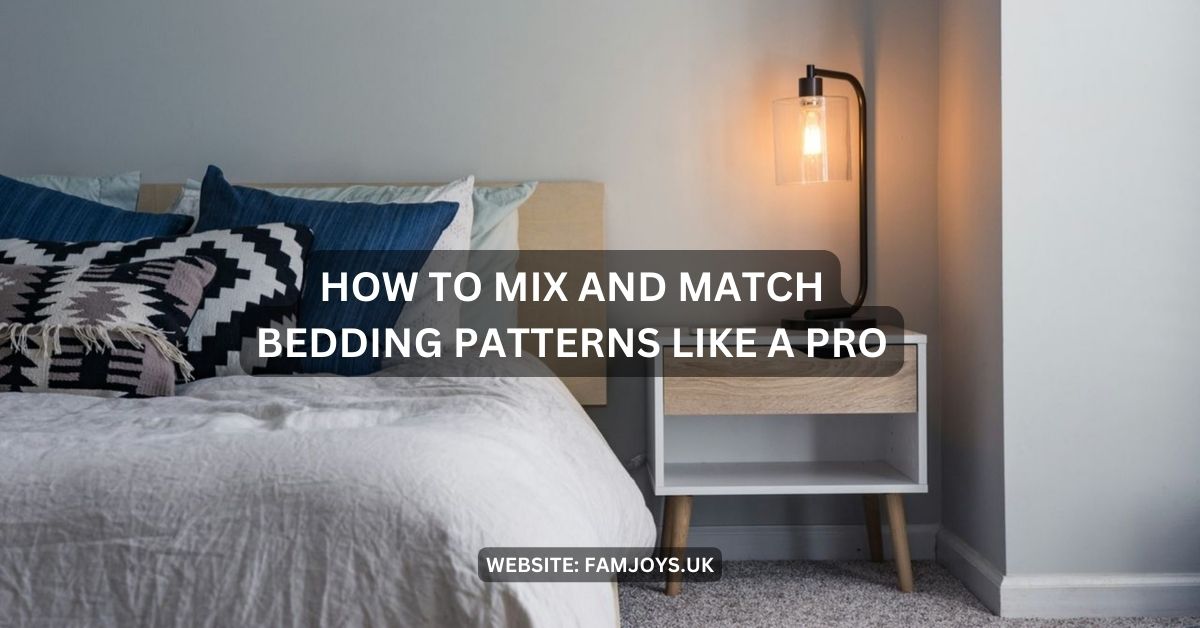Blog
How to Mix and Match Bedding Patterns Like a Pro
Mixing and matching bedding patterns can transform your bedroom into a stylish, personalized retreat—but it can also feel intimidating if you’re not sure where to start. The good news? With a few simple guidelines, you can confidently combine solids, stripes, florals, and more to create a cohesive and visually appealing look. In this guide, we’ll share expert tips for mixing patterns like a pro, so you can elevate your bedroom decor with ease.
1. Start with a Neutral Base
Before diving into patterns, establish a neutral foundation. This will help anchor your design and prevent the room from feeling overwhelming.
- Why It Works: A neutral base—like white, beige, or gray sheets and a solid-colored duvet cover—creates a calming backdrop that allows patterns to shine without competing for attention.
- How to Do It: Use neutral bedding as your base layer, then add patterned pillowcases, throws, or decorative pillows on top.
Pro Tip: If you prefer bolder colors, choose a single accent color (e.g., navy blue or blush pink) as your base instead of neutrals for a more vibrant look.
2. Follow the “80/20 Rule”
The 80/20 rule is a designer favorite when it comes to mixing patterns. This means 80% of your bedding should be solid or subtle, while 20% can feature bold patterns.
- Why It Works: This balance ensures your bed doesn’t feel too busy or chaotic. The solid elements provide visual rest, while the patterns add interest and personality.
- How to Do It: Pair a solid-colored comforter with patterned shams or throw pillows. For example, a white duvet cover could be paired with floral pillowcases and striped throw pillows.
3. Stick to a Unified Color Palette
One of the easiest ways to make mixed patterns work is by sticking to a cohesive color palette. Choose 2-3 colors that complement each other and repeat them throughout your bedding.
- Why It Works: A unified color scheme ties different patterns together, creating harmony and flow.
- How to Do It: If you’re using a floral print with greens and blues, incorporate those same colors in your striped or geometric patterns. Add solid-colored accents in matching shades to tie everything together.
Pro Tip: Use a color wheel to find complementary or analogous colors that work well together. For example, pair warm tones like terracotta and mustard yellow, or cool tones like teal and navy.
4. Vary the Scale of Patterns
When mixing patterns, vary their scale to create depth and avoid clashing. Combine large-scale prints with smaller, more intricate designs for a balanced look.
- Why It Works: Different scales keep the eye moving and prevent patterns from competing with each other.
- How to Do It: Pair a large floral print with a small geometric pattern or thin stripes. For instance, a bold botanical duvet cover could be paired with delicate striped pillowcases and a solid throw blanket.
Pro Tip: Avoid using two large-scale patterns together, as they can overwhelm the space. Instead, let one pattern take center stage and use smaller patterns as supporting elements.
5. Incorporate Texture for Added Interest
Texture plays a key role in mixing patterns because it adds dimension without relying solely on color or design. Layering different textures creates a cozy, inviting look.
- Why It Works: Textures soften the overall aesthetic and make the space feel more dynamic and layered.
- How to Do It: Combine smooth cotton sheets with a chunky knit throw, velvet pillows, or a quilted coverlet. Even subtle differences in fabric texture can enhance the visual appeal.
Pro Tip: Use textured solids (like a ribbed throw or linen pillow) to break up busy patterns and add balance to your design.
6. Use Solids as Buffers
Solids act as buffers between patterns, preventing them from feeling too overwhelming. They also give the eye a place to rest.
- Why It Works: Solid colors provide contrast and grounding, making it easier to mix multiple patterns.
- How to Do It: Place solid-colored pillows or throws between patterned ones. For example, if you have a floral pillow and a striped pillow, separate them with a solid-colored pillow in a complementary shade.
Pro Tip: Use solid-colored sheets or a duvet cover as your main piece, then layer patterned accessories on top for a subtle yet stylish effect.
7. Don’t Forget About Symmetry
Symmetry can help bring order to a pattern-heavy design. Arrange your bedding and accessories in a way that feels balanced and intentional.
- Why It Works: Symmetry creates a sense of calm and structure, which is especially important when working with multiple patterns.
- How to Do It: Place matching patterned pillows on either side of the bed, or use identical throws folded at the foot of the bed. For example, two floral pillows on each side of the bed can frame a solid-colored duvet cover beautifully.
Pro Tip: If you want to experiment with asymmetry, do so sparingly. For instance, layer a single bold-patterned pillow on one side of the bed for a playful touch.
8. Add a Pop of Unexpected Pattern
Once you’ve mastered the basics, don’t be afraid to introduce an unexpected pattern for a touch of personality. This could be something quirky, like polka dots or animal prints.
- Why It Works: An unexpected pattern adds surprise and flair, making your bedding feel unique and curated.
- How to Do It: Keep the rest of your bedding relatively simple, then add one bold element—like a leopard-print throw or a polka-dot pillow—to stand out.
Pro Tip: Limit bold patterns to small accents, such as a single pillow or a throw blanket, to avoid overwhelming the space.
9. Layer with Throws and Blankets
Throws and blankets are an easy way to incorporate additional patterns and textures without committing to a full bedding set.
- Why It Works: Throws allow you to experiment with patterns and colors without making a permanent change to your bedding setup.
- How to Do It: Drape a patterned throw over the foot of the bed or fold it neatly at the end. For example, a plaid throw could complement a floral duvet cover, while a striped blanket could add contrast.
Pro Tip: Fold throws in thirds lengthwise and drape them casually across the bed for a relaxed, lived-in look.
10. Final Touches: Accessories Matter
Accessories like rugs, curtains, and wall art can enhance your bedding’s overall aesthetic. Coordinate these elements with your bedding patterns to create a cohesive bedroom design.
- Why It Works: Accessories tie the entire room together, reinforcing the color palette and style of your bedding.
- How to Do It: If your bedding features botanical prints, choose a nature-inspired rug or artwork. If your bedding has a retro vibe, opt for mid-century modern furniture or vintage-inspired decor.
Pro Tip: Keep accessories minimal to avoid clutter. A few well-chosen pieces can make a big impact.
Conclusion
Mixing and matching bedding patterns doesn’t have to be daunting. By starting with a neutral base, sticking to a unified color palette, varying pattern scales, and incorporating texture, you can create a bedroom that’s both stylish and inviting. Remember to use solids as buffers, embrace symmetry, and don’t shy away from adding a pop of unexpected pattern for extra personality.
With these tips in mind, you’ll be able to mix and match bedding patterns like a pro—and turn your bedroom into a cozy, chic sanctuary.
Stay tuned for our next blog post, where we’ll explore “How to Care for Your Bedding: Tips for Extending the Life of Your Sheets, Comforters, and Pillows.”

